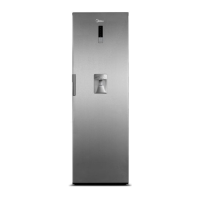
Do you have a question about the Midea HS-455LWEN-W1 and is the answer not in the manual?
| Appliance Type | Refrigerator |
|---|---|
| Model | HS-455LWEN-W1 |
| Brand | Midea |
| Category | Refrigerator |
| Placement | Freestanding |
| Product color | White |
| Refrigerant | R600a |
| Number of Doors | 2 |
| Climate Class | SN-T |
| Voltage | 220 - 240 V |
| Frequency | 50 Hz |
| Shelves Material | Glass |
| Ice Maker | No |
| Water Dispenser | No |
| Door hinge | Right |
Provides essential safety instructions and warnings for operating the refrigerator, covering electrical hazards and general precautions.
Details critical safety instructions and warnings related to the handling and properties of refrigerants used in the appliance.
Outlines the key features of the refrigerator, including its design and technological aspects.
Presents detailed specifications including electrical parameters, refrigerating temperatures, and defrosting components.
Provides guidance on safely handling and moving the refrigerator during installation, including unpacking and initial placement.
Recommends suitable locations and explains how to level the refrigerator for optimal performance and energy efficiency.
Details the process for reversing the door opening direction and installing the refrigerator's external handle.
Identifies and labels the key internal components and parts of the refrigerator for user reference.
Presents the external dimensions of the refrigerator, including front, side, and open door views with measurements.
Illustrates the refrigerant flow path through the various components of the refrigeration system.
Shows the airflow path within the refrigerator, detailing how cool air is distributed to maintain optimal temperatures.
Provides instructions for removing components located on the refrigerator door, such as the door seal and door tray.
Guides on how to dismantle internal parts like crisper covers, shelves, and drawers.
Explains how to access and remove the internal lighting components and the light switch.
Details the process for dismantling air duct components and the fan motor within the freezer chamber.
Describes the steps for removing the evaporator and temperature sensing components from the freezing chamber.
Covers the disassembly of the compressor case, including rear cover, condenser fan, and terminal box.
Provides instructions for safely removing the display control board and the main control board.
Introduces the refrigerator's operation panel, detailing button layout and display indicators for user interaction.
Explains how to adjust the operating gear or temperature setting of the refrigerator via the control panel.
Describes the 'Super Cool' function, its activation, operation, and exit conditions for rapid cooling.
Lists common fault codes displayed by the refrigerator and provides step-by-step solutions for troubleshooting.
Details the procedures for entering, operating within, and exiting various test modes for diagnostic purposes.
Explains how to initiate and interpret the refrigerator's self-diagnosis function for identifying operational issues.
Details the power supply circuit, including input voltage, filtering, and DC voltage conversion for internal components.
Explains the circuit used to detect the refrigerator door status (open/closed) and its operation.
Describes the temperature sensing circuit, utilizing NTC thermistors to monitor and regulate internal temperatures.
Details the electrical circuit for the fan motor in the freezing chamber, including operational checks and replacement advice.
Provides a table of resistance values for sensors at different temperatures, used for calibration and troubleshooting.
A flowchart guiding users through diagnosing and resolving issues related to the refrigerator's lack of cooling.
Provides a troubleshooting flowchart for identifying and addressing problems related to the compressor not working.
A flowchart to diagnose and fix issues related to undercooling or thermostat malfunction in electronic temperature-controlled models.
A flowchart to diagnose and resolve problems related to the failure of the refrigerator's fan system.
A flowchart to identify the source of noise within the refrigerator and suggest corrective actions.
A flowchart to troubleshoot issues where the internal lights of the refrigerator are not functioning.
Refers to figures for visual representation of repair parts, which are provided in separate documentation.
Contains detailed electrical schematic diagrams for the refrigerator's various circuits and components.
Lists essential tooling, equipment, and materials required for performing maintenance and repairs on the refrigerator.